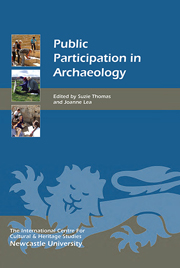Book contents
- Frontmatter
- Dedication
- Contents
- List of Illustrations
- Acknowledgments
- List of Abbreviations
- Preface
- Introduction
- Public Participation in Archaeology: International Models
- 1 From ‘Telling’ to ‘Consulting’: A Perspective on Museums and Modes of Public Engagement
- 2 Making Archaeological Heritage Accessible in Great Britain: Enter Community Archaeology
- 3 Public and Community Archaeology — an Irish Perspective
- 4 The Scope and Potential for Community Archaeology in the Netherlands
- 5 Public Archaeology as a Reflexive Practice: An Argentine Case Study in the Pampean Region
- Public Participation in Archaeology Through Education
- Public Participation in Archaeology Through Tourism
- Public Participation in Archaeology Through Site Management and conservation
- List of Contributors
- Index
3 - Public and Community Archaeology — an Irish Perspective
from Public Participation in Archaeology: International Models
Published online by Cambridge University Press: 05 August 2014
- Frontmatter
- Dedication
- Contents
- List of Illustrations
- Acknowledgments
- List of Abbreviations
- Preface
- Introduction
- Public Participation in Archaeology: International Models
- 1 From ‘Telling’ to ‘Consulting’: A Perspective on Museums and Modes of Public Engagement
- 2 Making Archaeological Heritage Accessible in Great Britain: Enter Community Archaeology
- 3 Public and Community Archaeology — an Irish Perspective
- 4 The Scope and Potential for Community Archaeology in the Netherlands
- 5 Public Archaeology as a Reflexive Practice: An Argentine Case Study in the Pampean Region
- Public Participation in Archaeology Through Education
- Public Participation in Archaeology Through Tourism
- Public Participation in Archaeology Through Site Management and conservation
- List of Contributors
- Index
Summary
Ideally this chapter would provide a ‘definitive’ summary of ‘where things are at’ with public and community archaeology on the island of Ireland in the second decade of the 21st century. Unfortunately however, much of the necessary information to produce such a summary — akin to Thomas' (2010) review for British community archaeology (and see Thomas, Chapter 2) — is not available for Ireland. Therefore I will instead provide a background on doing public and community archaeology in Ireland. This is important, as the Irish situation (in both Northern Ireland and the Republic) is very different from that in England, Scotland and Wales in terms of the protection of archaeological remains and thus of access to archaeology more generally. I will then discuss the potential for public participation in Irish archaeology, especially in light of the recent economic downturn's impact on the archaeological community.
Introduction and Background
The terms ‘public’ and ‘community’ archaeology have recently become widely used in Irish archaeological circles, in particular since the collapse of the contract archaeology industry (Kador 2011). However, whenever these terms are used it soon becomes apparent that different people have very different interpretations of what they may mean. Clearly, this is not only a problem in Ireland, and the possible meanings of community archaeology in particular have been widely debated in the literature. Some contributions have chosen to return to basics and outline what community may mean (Sen 2002; Marshall 2002) before discussing where this leaves community archaeology.
- Type
- Chapter
- Information
- Public Participation in Archaeology , pp. 35 - 48Publisher: Boydell & BrewerPrint publication year: 2014



